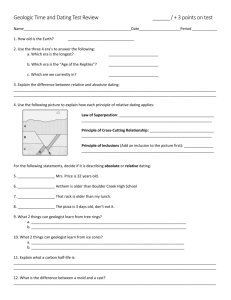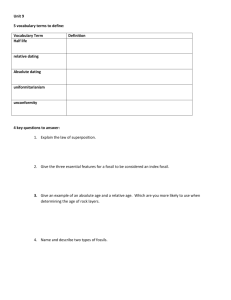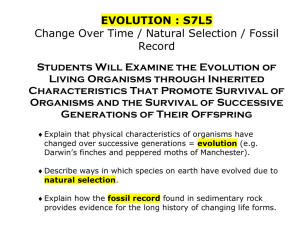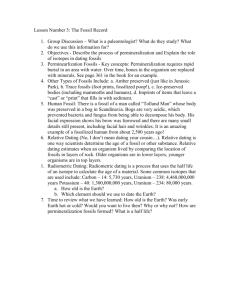KEY QUESTIONS How do we locate, recover, and date fossil remains?
advertisement
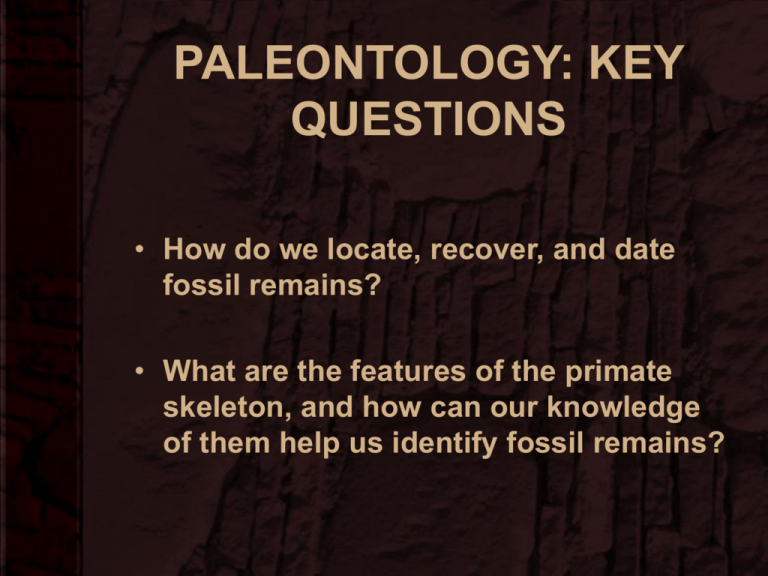
PALEONTOLOGY: KEY QUESTIONS • How do we locate, recover, and date fossil remains? • What are the features of the primate skeleton, and how can our knowledge of them help us identify fossil remains? THE FOSSIL RECORD: PRESERVATION –Not a representative sample of all of the species that have lived on earth –Some species and body parts preserve better than others –TAPHONOMY = study of the processes that affect the remains of dead animals THE FOSSIL RECORD: FINDING FOSSILS * More likely to be found in areas with little vegetation and lots of erosion (i.e. lake bottoms) * Due to issues regarding the preservation and discovery of fossils, the fossil record of early primates is “limited and spotty” DATING CONCEPTS • PALEONTOLOGY = study of ancient life through the fossil record • Anthropology & Paleontology -interested in establishing a chronology for primate and human evolution • Much dating depends on STRATIGRAPHY = study of the sequence of geographical layers RELATIVE DATING • Uses natural layers or strata to establish a relative chronology— material from this layer is older than the material from that layer • Association with known fossils, biostratigraphy = most common method of fossil dating ABSOLUTE DATING (p.202!) • Produce dates in years, so differences in age can be quantified • Radiometric techniques = based on known rates of radioactive decay in elements found in or around fossils • Radiocarbon (Half-life of 14C is 5,730 yrs.), dates organic remains from 100s to 40,000 ya (half life = time needed for ½ amount of 14C to decay) • Potassium Argon (K/A) dates volcanic rock from 100,000 to billions ya ABSOLUTE DATING • Electron Spin Resonance (ESR) = Measures # of electrons excited to higher energy levels by natural radiation & trapped at those levels, dates teeth & cave deposits from 100s to 10 mya • Luminescence = Same as ESR, but trapped energy is released using heat or light, dates pottery, bricks, burned rock up to 800,000 ya Hypothetical Stratigraphic Sequence •IF Humanlike remains were found between two layers of volcanic rock, how could we date the remains? • K/Ar (potassium/argon) dating • Remains are younger than the volcanic deposit below and older than the one above Absolute Dating Techniques Technique Abbreviation Materials Dated Effective Time Range Carbon 14 14C organic materials up to 40,000 years PotassiumArgon K/A and 40K volcanic rock older than 500,000 years Uranium Series 238U minerals between 1,000 and 1,000,000 Thermoluminescence TL rocks and minerals between 5,000 and 1,000,000 years Electron Spin Resonance ESR rocks and minerals between 1,000 and 1,000,000 years Continents At End of the Mesozoic Tethys Seaway Placement of the continents at the end of the Mesozoic and beginning of the Cenozoic, about 65 mya Cenozoic Timescale Taphonomy • Leopard + remains of early hominid in tree above entrance to cave • Accumulation of bones, including hominid bones, in South African caves • Bones, antlers, teeth found in the caves once thought to be early tools used by bipedal “killer apes” to hunt and forage • Taphonomic research now shows that they are a natural accumulation & the “killer apes” were prey not predator! Skeletal Anatomy Skeletons of: • Modern Human • Gorilla • Domestic Cat Comparative Primate Anatomy Differences in stance: Indri: Vertical clinging and leaping Macaque: Generalized quadrupedalism Gorilla: Semi-erect knuckle walking Chimp: Knucklewalking and tree climbing Human: Fully erect bipedalism Cranial Anatomy • Hominoid primates share same overall construction of the skull • Proportions of the various bones of the skull, however, vary, as do the expression of various ridge-like features on surface of the bone • What do you think are some of the reasons for these differences? Brow ridge Frontal Sagittal crest Axial Skeleton (Trunk) of OW Primates Changes in the anatomy of the trunk Hominoid Comparative Anatomy Changes in Human Skeleton 1. Skull more balanced on spine 2. Smaller neck muscles 3. Spine articulates under skull 4. Multiple curves of spine 5. Narrower rib cage Changes in Human Skeleton (cont.) 6. Shorter wider pelvis 7. Proportionately longer legs 8. Upper leg angled inward so knees closer to midline 9. Big toe in line with other toes 10. Center of gravity in pelvic basin



